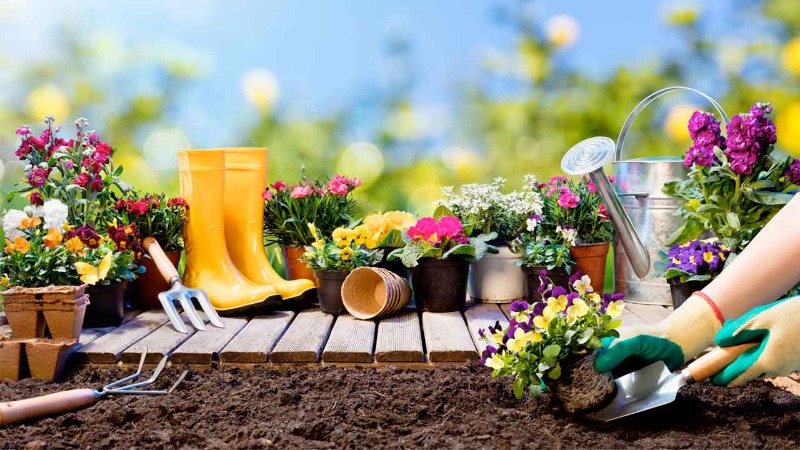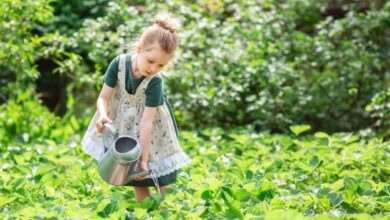
15 Gardening Ideas That Every First-Time Gardener Should Know
We have all dreamed of having a splendid garden that, in addition to beautifying our home, serves as a refuge when stress overwhelms us. Lack of experience should not discourage us! Gardening is an art that requires dedication and specific knowledge but can be learned slowly.
For this reason, and with the aim of helping people who until now are immersed in this magical world, we have decided to compile the following gardening tips for beginners. We hope they will be of great help.
1. First of All, Define The End of the Garden
A garden can be used to plant flowers of a thousand colors, create appropriate spaces for recreation and grow vegetables. Therefore, from the beginning it is necessary to define the function that it will fulfill and clearly delimit the areas destined for each purpose.
That way we will be clear about what we want and it will be much easier for us to visualize how we will build it. If the budget allows it, it is worth hiring the services of a landscaper to help us with the design. Thus, we will obtain a perfect mix between colors, heights and locations.
2. Assess The Climate of the Area
Before buying the plants we must know in depth the climatic conditions of the area in which we intend to develop our garden (warm, desert, tropical, humid, cold, etc.). In this way, when visiting the nursery, we will be able to choose, with the advice of the professionals of the place, flowers, bushes, herbs and shrubs that will really adapt to the climate in which they will be planted.
In this regard, we cannot ignore the so-called microclimates, which refer to the specific climate of much smaller areas. For example, the microclimate of a place that receives sun all day is not the same as that under a leafy tree.
3. Take into Account the Light Intensity
All plants require light to live, although in different amounts and intensities. For example, even if the label on a certain bush says it is for outdoor use, it may not withstand direct exposure to sunlight for a long time, or it may only support diffused sunlight, as is the case with orchids.
Therefore, before sowing any plant, we must read the instructions in this regard well or request advice from the nursery where we buy them. Thus, we guarantee your location in the perfect place.
4. Evaluate The Substrate or Terrain
There are plants that require sandier and drained soils to live, such as cacti; others, like heliconia, prefer more clayey and humid soils. That is to say: each type needs a specific substrate.
Consequently, before sowing we must know the type of land in our garden and cover it with organic compost. In this way, we fertilize naturally and promote biological activity in the soil, obtaining healthier plants as a result. The same logic applies to the bushes that we plant in pots.
5. Water The Plants at The Correct Frequency
Most beginning gardeners believe that the more water they apply to their plants the faster and healthier they will grow. Big mistake. Not all plants need the same amount of water to live.
Usually, outdoor plants should be watered at least once a week, but the cycle can vary depending on the species, weather conditions, and evaporation levels in the area where we have the garden. Therefore, it is wise to seek the best advice in this regard at your closest amazon store with a gardening amazon promo code to avail best discounts. In any case, let us remember that irrigation is done on the ground and not directly on the leaves or flowers of the plants. That makes them prone to pests and rot.
6. Proper Fertilization
Another common mistake made by beginners is to fertilize plants just arrived from the nursery. There is no need for it. These are usually already well fertilized. The prudent thing is to wait for them to stabilize and adapt to their new home, or wait for the first pot transplant. Otherwise each plant needs different types of fertilizers.
7. Frequent Pruning
If we want to see our plants healthy, we have to prune them with a certain frequency to eliminate the elements that prevent the passage of sunlight to the entire garden or affect their normal development (damaged flowers, rotten fruits or dry, broken and diseased branches). Let’s not forget that specific pruning varies from one species to another; therefore, we must inform ourselves about it.
8. Acquire the Basic Tools
Part of being a good gardener is to acquire and properly select the tools and utensils to take care of our garden, some of the basic utensils that we must have are:
- Shovel (various sizes for different types of garden and pots)
- Rake
- Pruners and brush cutters
- Gardening scissors
- Cut branches
- An irrigation hose and sprinklers
- Pots and containers
- Gloves
- Work wear
With these tools and utensils, we can perform the basic gardening tasks, typical of those who until now are starting in this art. Over time our knowledge will increase, along with our equipment needs.
9. Take into Account the Height of the Plants
When planting our plants, we must bear in mind the height of each one of them, so that as the taller ones grow they do not deprive the smallest of light, causing them to die. Or on the contrary, planting without considering the excess of sun for some.
10. Seed Storage
One of the best gardening tricks is to store seeds, stems, and more in clean jars and dry places. This way we prevent them from germinating on their own. It is better to keep them safe in polytunnels.
11. Allow Insects to Live in The Garden
Not all insects are harmful. Some, like bees and butterflies, pollinate flowers; others can be harmful if they are presented too much. In the same way, worms, although they are not properly insects, provide nutrients to the earth through their excrement, aerate the soil and control its PH. In that sense there are many more animals that are beneficial for our garden. We must ensure that they are preserved.
12. Watch Out for The Roots
There are plants whose roots can spread through the ground, preventing the growth of those that are next to them and even affecting the walls. The most prudent thing is to plant them in containers or in remote places where they will not cause any damage.
13. Care When Transplanting
Many garden beginners make a serious mistake when transplanting newly purchased plants. These usually come in a pot. The inexperienced gardener simply takes them out of there and immediately introduces them into the previously dug hole. This can cause the roots to roll into each other and not expand, leading to rotting from watering.
Ideally when transplanting them is to take the roots, very carefully, from the inside out until they take their natural place. This step is essential, especially in cases where the plant has been in a pot for too long.
14. Beware of Pests
It is important to periodically inspect the leaves and stems of plants for harmful parasites or fungi. In case of detecting them, we must cut the affected parts and burn them or discard them in closed containers to be removed by the relevant body. If the problem persists, we have no other solution than to immediately apply a specialized product, preferably natural or recommended by an expert in the field.
15. Keep an Agenda of the Plants
Once the garden has been planted, it is important to consolidate in a single agenda a list of the plants we have, noting their flowering period, fertilizer, pruning and other important information for their maintenance.
These 15 gardening tips for beginners will be a great help to get started in this beautiful art. Ideally, of course, we should start studying all we can about gardening and botany, in order to add theoretical knowledge to practice and become experts in the field.
To complete the ideal garden, it is recommended to review the accessories to the garden fauna, that is, the special outdoor furniture or the barbecue. Another example is lighting that helps our garden look just as impressive day and night.
Author’s Bio:
Selena is a blogger and a guest contributor for a well-known brand that includes Mesheble and The Ordinary. In her leisure time, she plays tennis.



